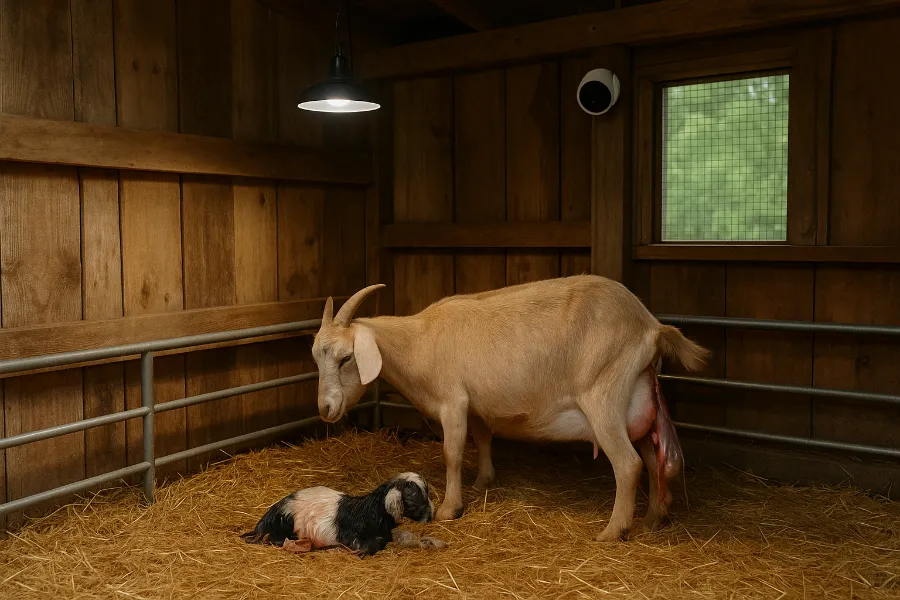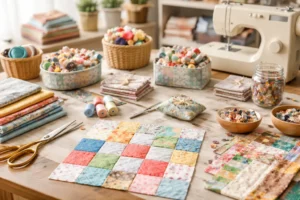When I think back to the first time I helped a doe through goat kidding, my heart still races. The sound of her soft bleats, the first glimpse of a tiny nose poking through, and the rush of realizing new life is about to begin — it never loses its magic. Over the years, I’ve learned that knowing how to assist a goat during kidding can make all the difference between a calm, healthy birth and a stressful one.
Through countless late nights in the barn, I’ve combined what generations of farmers taught me with a few smart modern tools — and together, they’ve changed the way I manage every kidding season. Whether you’re new to goat farming or seasoned but seeking a smoother approach, this guide will walk you through everything: from recognizing goat labor and setting up a safe goat stall, to caring for the goat udder and newborn kids after birth.
Goat Care: The Foundation Before Kidding
Successful kidding starts long before labor begins. Proper goat care throughout pregnancy is your first safeguard against complications. I start by focusing on nutrition, comfort, and calm — three things that set my does up for a smooth kidding experience.
Here’s my pre-kidding care routine:
- Feed quality hay and a protein-rich supplement like alfalfa.
- Keep fresh water and loose minerals available at all times.
- Check hooves monthly — overgrown hooves can strain joints during labor.
- Deworm and vaccinate appropriately, especially with CDT before due dates.
- Watch body condition — too thin or too fat can both make labor harder.
A healthy, happy doe means fewer interventions and less stress when the big day comes.
Goat Breeding: Setting the Stage for Easier Births

I learned early that goat breeding choices can shape every kidding that follows. Choosing the right buck isn’t just about pedigree — it’s about size, temperament, and the doe’s compatibility. Smaller-framed does bred to large bucks often have harder labors.
To make things easier, I:
- Track all breeding dates to estimate due dates (about 150 days later).
- Keep records of previous kiddings — how long they took, any complications.
- Rotate bucks and does to maintain healthy genetic variety.
Good breeding practices don’t guarantee an easy kidding, but they reduce surprises — and that’s half the battle.
Goat Stall: Creating a Safe, Stress-Free Birthing Space
When kidding season nears, I set up a dedicated goat stall just for my expecting does. It’s more than just a pen — it’s their birthing suite.
Here’s what my ideal kidding stall includes:
- Size: Around 4×6 feet, just enough room for the doe to turn and stretch.
- Walls: High enough to block drafts, low enough for me to reach over.
- Lighting: Soft, adjustable, and gentle — bright light can startle does.
- Supplies: Clean towels, iodine, gloves, lube, scissors, and a bucket of warm water.
- Camera or sensor: I use a small barn camera or motion sensor to monitor labor quietly from afar.
It’s amazing how much calmer the does are when they feel secure in their own space — and how much smoother births go because of it.
Goat Bedding: Comfort and Warmth for Safe Deliveries
Never underestimate the power of good goat bedding. I use straw because it’s soft, insulating, and easy to clean. During colder months, I add wood shavings underneath for extra absorption.
Before each kidding, I replace the bedding with a fresh layer so the newborns have a dry, clean surface. After birth, I change out soiled areas right away. A warm, dry floor not only keeps kids cozy but also helps prevent infections and chills.
If you’re mixing tradition with tech, modern barn sensors can even help monitor stall humidity — alerting you when bedding becomes too damp. It’s a small upgrade that makes a big difference.
Goat Temperature: The Early Sign Labor Is Near
Every experienced goat keeper knows to keep a thermometer handy during kidding season. A drop in goat temperature is one of the best early indicators that labor is approaching.
A healthy doe’s temperature usually ranges between 101.5°F and 103.5°F. When it dips below 100°F, it’s time to pay attention — labor is likely within 12 to 24 hours.
I used to check manually every morning and night. Now, I sometimes use a collar with a built-in temperature sensor that alerts my phone. Whether you’re old-school or tech-assisted, catching that temperature drop early means you can prepare your kidding kit and stay nearby.
Goat Labor: Recognizing the Stages
When goat labor begins, patience and observation are key. Every doe has her rhythm, but the stages are universal.
Stage One – Early Labor
This stage can last for hours. You’ll notice restlessness, pawing, talking to her belly, or isolating herself. She may refuse feed and start breathing faster. Her ligaments soften, and you might see clear discharge.
Stage Two – Active Labor
This is when the water bag appears and breaks. Within minutes, you should see two tiny hooves and a nose — the classic “dive position.” Each contraction pushes the kid further. If you don’t see progress after 30 minutes, it may be time to assist.
Stage Three – Placenta Delivery
After the kids are born, the afterbirth (placenta) should pass within 12 hours. I let the doe rest, drink molasses water, and tend to her babies.
Each of these stages requires calm attention — your presence matters more than your tools.
Birthing Goats: When and How to Assist
Knowing how to assist a goat during kidding is part skill, part intuition. Not every doe needs help — but when she does, confidence and gentleness make all the difference.
When I decide to assist:
- If the water bag has been out for over 30 minutes with no kid visible.
- If I see one hoof or head but not both (malpresentation).
- If the doe pushes without progress or seems too weak.
How I assist safely:
- Wash my hands and arms thoroughly, then wear gloves.
- Lubricate generously — friction is your enemy during repositioning.
- Feel gently for hooves and head. The ideal position is two front legs and a nose.
- If a leg is back, I wait for a contraction and gently bring it forward.
- Pull only when she pushes — never forcefully. Slow, downward traction helps.
Sometimes, the best help is just being there, guiding her through contractions with quiet encouragement. I still whisper, “You’ve got this, girl,” every single time.
Goat Giving Birth: Staying Calm Through the Process
When your doe is giving birth, your energy sets the tone. I dim lights, keep the barn quiet, and move slowly. Goats are sensitive; if you’re anxious, they’ll feel it too.
Once a kid is born, I immediately clear the nose and mouth, then hand the kid to the mother so she can lick and bond. The licking stimulates circulation and helps the kid start breathing on its own.
I only step in fully if the kid isn’t breathing — a quick towel rub, or gently swinging the kid downward once to clear fluid usually does the trick. Once breathing steadies, I wrap them in a towel and make sure they find the udder quickly.

Goat Colostrum: The First Milk of Life
That first feeding of goat colostrum is non-negotiable — it’s the newborn’s immune system in a bottle. Each kid needs to nurse within the first hour after birth. Colostrum is thick, creamy, and packed with antibodies that protect against disease.
If a kid can’t nurse right away, I hand milk the doe and use a bottle or syringe. I also freeze extra colostrum during the season — it’s my insurance policy for weak kids or emergencies.
Watching a baby latch and gulp down that first warm mouthful never gets old — it’s the moment you know they’ve made it through the hardest part.
Goat Milk: Transitioning from Birth to Milking
Once colostrum production ends after a few days, the doe’s goat milk begins to flow normally. This is when nutrition, hydration, and rest become vital for her recovery.
I offer warm molasses water right after kidding for energy, then gradually return her to her normal feed routine. Within a few days, I start hand milking lightly to relieve pressure and encourage production — but only once the kids are nursing well.
If you plan to share milk, practice clean milking from day one. Sanitize your buckets, wash hands, and strain milk immediately after collection. Healthy does produce healthy milk.
Goat Udder: Post-Kidding Care and Health
Caring for the goat udder after kidding is essential for preventing mastitis. I check for even fullness and warmth in both halves. A lumpy, hard, or hot udder signals trouble.
To keep things in balance:
- Massage lightly before and after milking.
- Keep bedding dry and clean — moisture invites bacteria.
- Wash teats with warm water before and after milking.
- Use a teat dip or natural balm if cracks form.
Some farmers use infrared or temperature sensors to monitor udder health, but even simple hands-on checks go a long way.
Goat Barn: Where Tradition and Technology Meet
The goat barn is the heart of kidding season — and mine has slowly evolved from a simple wooden shed to a smart, cozy birthing zone.
My essentials include:
- Good airflow to prevent respiratory issues.
- Smart heat lamps for warmth without overheating.
- Motion-sensor cameras for quiet observation.
- Humidity monitors to ensure a dry environment.
- Separate pens for new moms and kids to rest peacefully.
These upgrades save me countless midnight trips outside while keeping my goats comfortable and safe.
Farm Technology: How Modern Tools Make Kidding Easier
Technology doesn’t replace instincts — it enhances them. Modern farm technology tools are changing how we manage kidding season without losing the personal touch.
Here’s what I rely on:
- Kidding alert sensors that detect contractions and send notifications.
- Temperature collars that warn of pre-labor changes.
- Barn cameras for night monitoring without disturbing the doe.
- Smart feeders and waterers that ensure nutrition even if I’m busy.
- Apps for herd management that log due dates, births, and health notes.
Even in the middle of a freezing night, I can check everything from my phone. It’s the perfect mix of care and convenience.
Smart Farming: Balancing Innovation and Instinct
To me, smart farming isn’t about gadgets — it’s about using technology to free up time for what truly matters: connecting with my animals. The sensors and alerts don’t replace the sound of a mother goat calling her newborn, or the satisfaction of wiping a tiny nose after birth. They simply make it easier to be in the right place at the right time.
Every kidding teaches me something — about patience, observation, and respect for life. Mixing tradition with innovation has helped me raise stronger herds and become a more confident caretaker.
Final Thoughts: The Heart of Goat Kidding
Every birth in my barn reminds me why I started farming goats in the first place. Goat kidding is equal parts science and soul — a mix of instinct, compassion, and readiness.
No matter how advanced our tools become, the heart of it all stays the same: a farmer, a doe, and the first cry of new life in the straw. Whether you’re guiding with gloved hands or watching quietly from the shadows, what matters most is being there — calm, steady, and ready to help when she needs you.
FAQs
A doe may isolate herself, paw at the ground, and show a drop in body temperature. You might also notice discharge and soft tail ligaments 12–24 hours before birth.
Step in if active labor lasts more than 30 minutes with no visible progress, or if the kid appears in an abnormal position such as breech or head-only.
Include clean towels, gloves, lubricant, iodine, scissors, a bulb syringe, and a thermometer. Having everything ready helps you act quickly if needed.
Always wash, glove, and lubricate your hands before gently checking the presentation. Move the kid only during contractions, and stop if resistance feels firm.
Kids should nurse within the first hour to get vital goat colostrum, which boosts immunity and energy. If they’re weak, bottle-feed hand-milked colostrum.
Offer warm molasses water, fresh hay, and a quiet, clean stall. Check her udder for swelling and ensure she passes the placenta within 12 hours.
Smart collars, barn cameras, and temperature sensors alert you when labor starts. These tools make it easier to monitor does without disturbing them.













